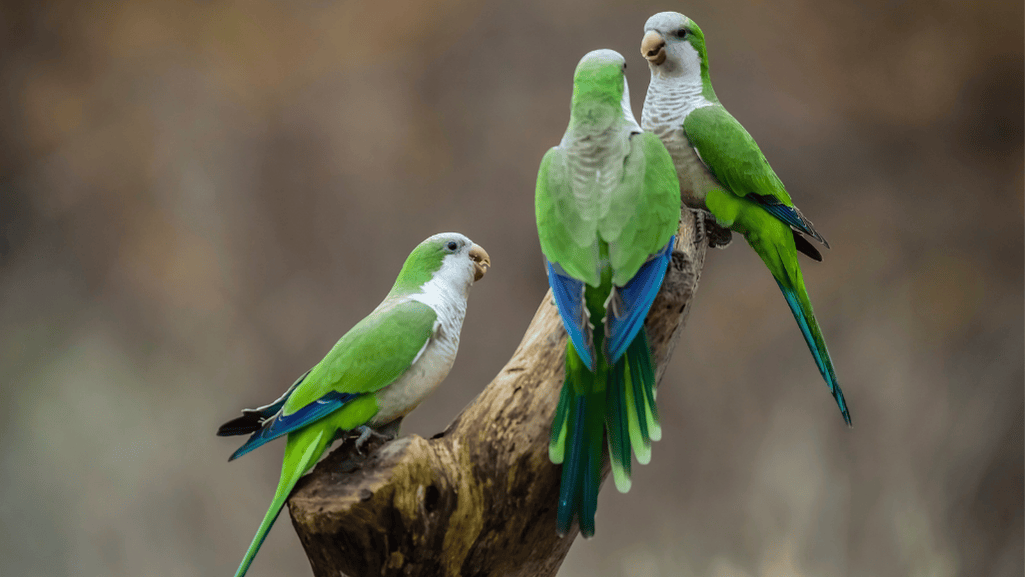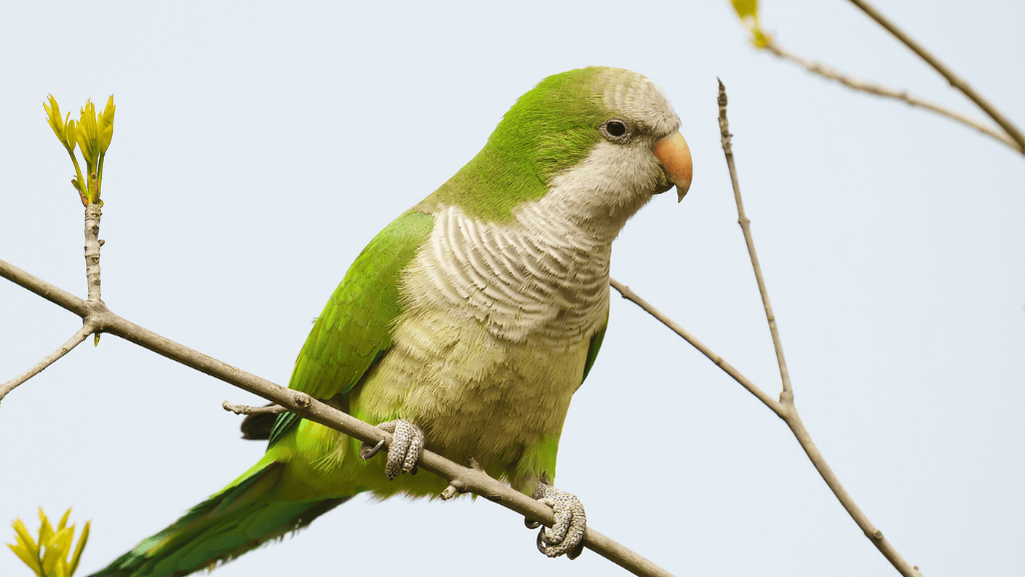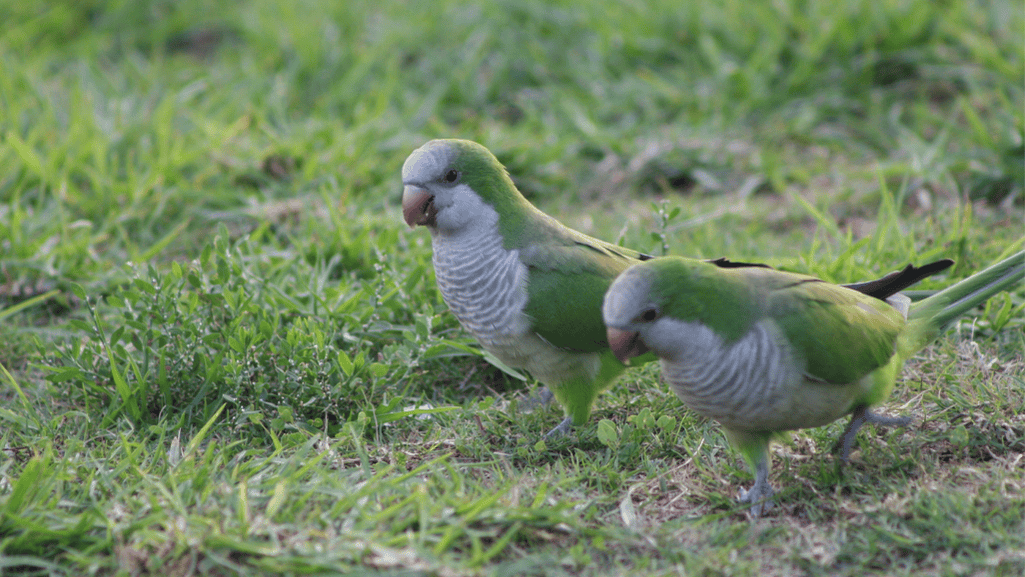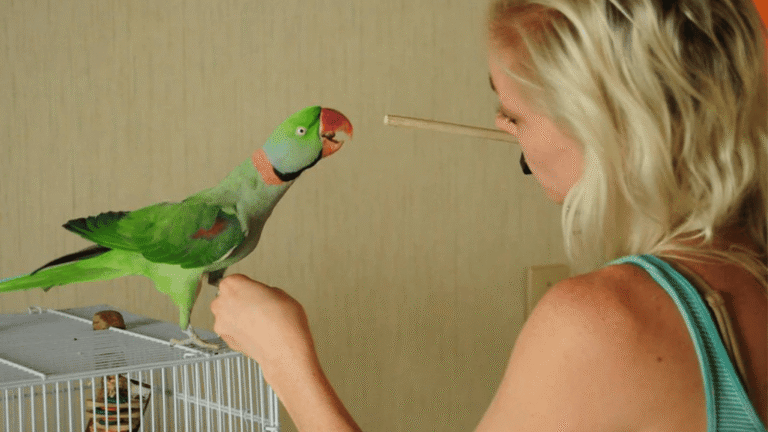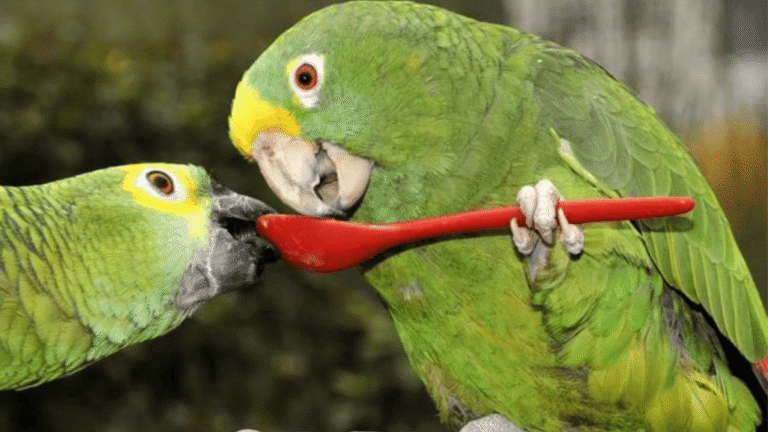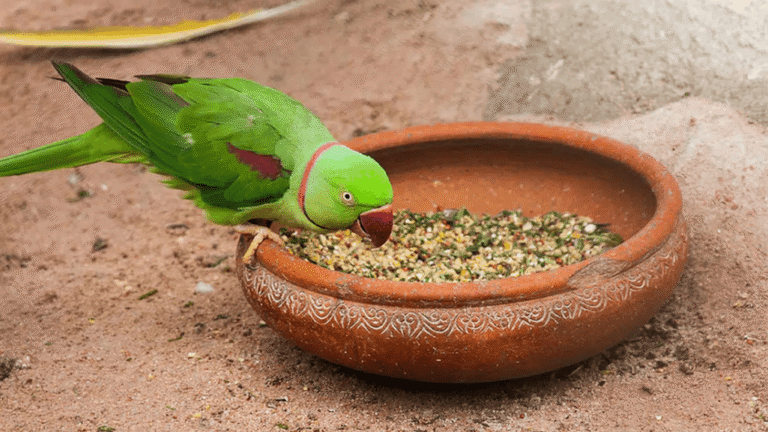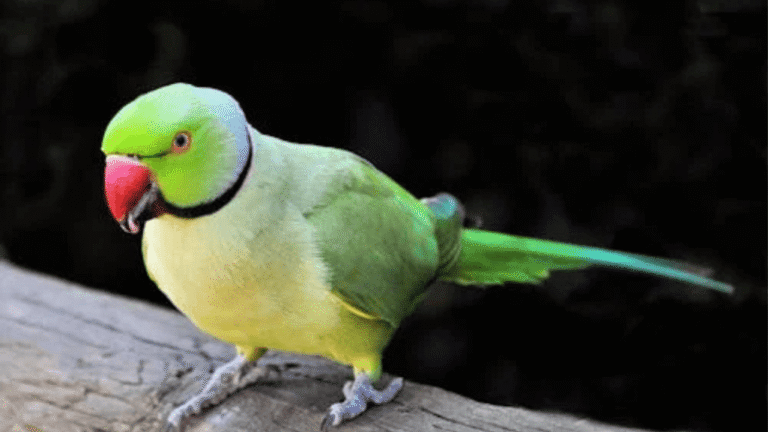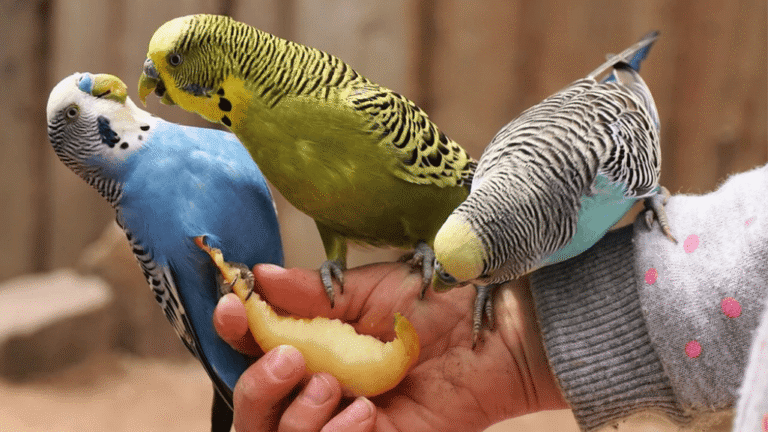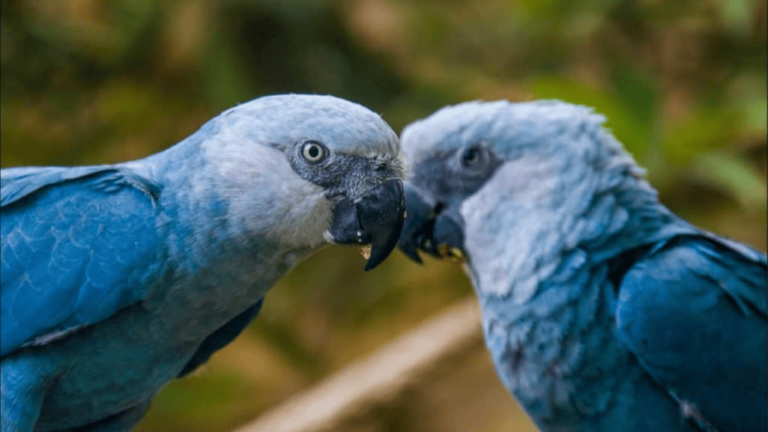The Monk Parakeet, known scientifically as Myiopsitta monachus, brings color and life to any space. Their bright green feathers and smart nature make them stand out. These birds are known for their ability to mimic sounds and their love for interaction. This makes them a great choice for those who want a pet that can talk and connect.
Monk Parakeets show their mood through a unique shaking motion. They also have complex nesting habits. These traits make them fascinating to bird lovers. If you’re thinking of getting a monk parakeet pet, know that they can live a long time and need a lot of attention.
Key Takeaways
- Monk Parakeets have a considerable lifespan of 20 to 30 years, demanding long-term care and dedication.
- Adequate living space is essential, with a recommended cage size of 18 inches square or larger necessary for their active lifestyle.
- The diet of a Monk Parakeet should be balanced, comprising approximately 60% seeds and 40% fresh fruits and vegetables.
- They are social creatures requiring at least two hours of interaction and playtime outside their cage daily.
- It’s important to be aware of the legal considerations, as Monk Parakeets are restricted in certain states.
- Understanding their health requirements is vital, keeping an eye out for common issues such as obesity and fatty liver disease.
- Prospective owners should be prepared for the costs involved, including the initial price and ongoing expenses for care.
Discovering the Monk Parakeet: An Introduction
The monk parakeet, also known as the quaker parrot, is a species with a rich history and personality. They come from South America’s temperate regions. These birds have adapted to many places around the world. They are loved by bird lovers for their bright colors and smart behavior.
Historical Significance and Names
These birds are often called monk parrots or quaker parrots. They get their name from their gray feathers that look like a monk’s robe. They are calm and friendly, making them seem like monks.
Studies show they were once found over wide areas. This shows how adaptable and strong they are. For more on their history, check out this article on monk parakeets.
Distinctive Appearance and Personality Traits
Monk parakeets have bright green feathers and a charming personality. They are known for their monk parakeet intelligence. They can solve problems and even talk like humans.
They live in groups and build big nests. This helps them stay close to each other. Watching them shows how smart and social they are.
People are drawn to monk parakeets for many reasons. They are not just beautiful and smart. They are also interesting to care for. Learn more about them and their care here.
Understanding Monk Parakeet Behavior
The monk parakeet is known for its vibrant social interactions and dynamic presence. It exhibits fascinating behaviors that are key to its identity. These birds are famous for their monk parakeet vocalizations, making a wide range of sounds beyond just chirping. Research, like that in studies on limb morphology and behavior, sheds light on these vocalizations and their environment.
When talking about monk parakeet noise levels, it’s important to note they don’t scream loudly like some parrots. Their calls and chatters are moderate, fitting well for both apartment and home environments. This balance makes them great companions in social settings.
Another key aspect of monk parakeet characteristics is their adaptability to different environments. They form tight colonies, engaging in communal activities like building nests and sharing food. This social structure helps them survive in various climates and shapes their behavior, from breeding to feeding.
They are also adaptable in their diet, changing from seeds and fruits in the wild to a more varied diet in captivity. This flexibility makes them delightful and resilient pets.
Young monk parakeets often quiver or shake, showing excitement or hunger. These birds love to play, which keeps their minds and bodies active. It also strengthens their social bonds.
In summary, understanding the behaviors and monk parakeet characteristics helps owners care for them better. It also deepens the bond between humans and parrots, revealing their complex and engaging nature.
Evaluating the Lifespan of a Monk Parakeet
Understanding the monk parakeet lifespan involves looking at several factors. These factors affect their health and how long they live. With the right monk parakeet care, these birds can live for many years. Owners need to create a caring environment for them.
Lifespan Factors: Diet and Environment
The diet of monk parakeets is key to their health and lifespan. They should eat high-quality pellets, fresh fruits, and veggies. This diet should be diverse, like what they find in the wild.
Environmental factors are also crucial. They need a big cage, at least 24”x30”x24”, with enough space to move. This helps prevent obesity and other monk parakeet health issues. Adding different perches and toys keeps their minds active, just like in the wild.
Health Issues and Longevity
Monk parakeets are usually healthy birds. But, they can face health problems that shorten their lives. Obesity is a big risk, caused by too little exercise and too much fat in their diet. This can lead to fatty liver disease, a serious condition.
Other health issues, like self-mutilation and stress, can also happen. These problems often come from not meeting their needs. Daily interaction and a rich environment are key to their well-being and long life.
Is a Monk Parakeet the Right Pet for You?
Thinking about getting a monk parakeet as pets means looking at their care, social needs, and living space. Knowing about their natural behaviors and what they need at home helps decide if your place is right for them.
Monk parakeets love to be around people or other birds. This is key for their happiness and health. If you’re thinking of getting one, remember they can form a strong bond with you. But, if you get more than one, watch how they get along, especially if they’re grown.
These birds can live over 35 years, so you’re making a big commitment. Here’s a useful look at what caring for them involves.
| Housing Conditions | Socialization Benefits | Care Complexity |
|---|---|---|
| Needs space 1.5 times wingspan wide and 3 times long. | High social needs; may bond with other birds or owners. | Needs daily interaction; smart and can change behavior. |
Monk parakeets are full of energy and need lots of room to move and think. You’ll need to give them lots of perches and spend time with them. Also, getting them from a rescue can be tricky because they might be territorial at first.
In short, having a monk parakeet is rewarding but it’s a big responsibility. Make sure you can handle their needs and provide a stable home for many years before bringing one into your family.
The Monk Parakeet’s Habitat Preferences
The monk parakeet, a vibrant and social bird from South America, has adapted well to different places. They are found in many parts of the world, including the US. Their ability to live in various environments makes them interesting to study.
From South American Origins to Global Presence
Originally from Argentina and Brazil, monk parakeets live in woodlands and savannas. They build complex nests in trees or on structures, helping them spread beyond their home. Research shows these nests protect them from predators and extreme weather.
Creating Suitable Home Environments
Monk parakeets need a good home to thrive. They need big cages with toys and perches. Keeping more than one bird together is best, as it mimics their natural social life.
Managing monk parakeet populations in the US is important. Understanding their natural habitats and social structures is key. This improves their lives and helps with conservation efforts.
Monk Parakeet Diet and Nutrition
The health of monk parakeets depends a lot on their diet. It’s key to understand and manage their diet well. This can help prevent diseases and improve their life quality.
Essentials of a Balanced Diet
A monk parakeet’s diet should include high-quality pellets, fresh fruits and veggies, and the right nutrients. Experts say 60-80% of their food should be pellets or complete foods like Lafeber Nutri-Berries. These foods have 40 essential nutrients.
Fresh foods like pomegranates, blackberries, kale, and broccoli are also important. They add vitamins and minerals for strong health.
- Nutri-Berries come in several tastes: Original, El Paso, and Tropical Fruit, catering to different preferences.
- Sprouting seeds like those from Kaytee Exact Rainbow Original provide vital Omega-3 fatty acids that support heart and eye health.
- It’s advised to rotate foods every 3-4 days to prevent dietary monotony and ensure a range of nutrients.
Monitoring Foods for Optimal Health
Managing their diet is key to avoid obesity and diseases from bad nutrition. Monk parakeets need 1-3 tablespoons of calcium daily for kidney health. Their diet should be watched to avoid too much fat and sugar.
Changing their water and food slowly helps them adjust without stress.
Watching their food intake can also spot diseases early. Changes in eating habits or behavior are important signs. These signs may mean their diet needs to change or they need a vet visit.
Also, a diet that mimics their natural habitat is good. It encourages their natural foraging behavior. This is important for their mental and physical health.
Crafting the Perfect Monk Parakeet Habitat at Home
To create a great home for a monk parakeet, you need to know what they need. They need a lot of space and things to do to stay happy and healthy. Every part of the monk parakeet cage setup should make them feel safe and encourage them to learn and explore.
Cage Size and Placement
The cage should be big enough for the bird to move around. It should be 48” x 48” x 48” with bars that are ½” to ⅝” apart. This size helps keep them healthy and lets them fly a bit, which is good for their muscles.
The cage should be in a quiet spot, away from loud noises and extreme temperatures. It should also get natural light, matching the bird’s natural day-night cycle.
Providing Mental and Physical Stimulation
Monk parakeets need toys to stay sharp and active. They should have toys that make sounds, are cuddly, puzzle-solving, and can be destroyed. These toys help them act like they’re in the wild, like foraging and building nests.
It’s important to change the toys often to keep things interesting. Having at least one toy from each category in the cage at all times is best. This way, they get to do all sorts of fun things.
In short, a well-thought-out habitat is key to a monk parakeet’s happiness and health. With the right cage, toys, and nesting spots, they can be wonderful pets for many years.
Caring for Your Monk Parakeet: Socialization and Attention
The art of monk parakeet socialization is key to a healthy, interactive bird. These vibrant birds need consistent, loving attention from their caretakers. Knowing their monk parakeet attention needs helps build a strong bond. Regular talks and treats are not just fun but crucial for their social health.
Introducing your bird to friends and family is a vital part of monk parakeet care tips. This helps them adjust well and reduces stress around new people. By getting guests involved, you expand your parakeet’s social circle. This boosts their trust and comfort around others.
Ensuring a monk parakeet receives ample socialization is fundamental to its wellbeing, necessitating regular interaction and attention from its human companions.
- Training sessions using positive reinforcement help in improving their social skills.
- Introduce new individuals slowly and in a controlled environment to build trust.
- Include regular, gentle handling to foster familiarity and ease in handling.
- Provide opportunities for your parakeet to observe social interactions from a safe space.
This holistic approach to monk parakeet care promotes a balanced lifestyle. It improves both their mental and physical health. For more on parakeet care, visit LoveCare4Pets.
| Socialization Technique | Benefits | Frequency |
|---|---|---|
| Interactive Play and Training | Increases trust and reduces anxiety | Daily |
| Gentle Handling by Various People | Improves adaptability and reduces fear towards strangers | Weekly |
| Controlled Exposure to New Environments | Enhances adaptability | Monthly |
Monk Parakeet Breeding Habits and Considerations
Learning about monk parakeet breeding habits means understanding their social lives and how they reproduce. These birds adapt well to different places, which affects how they breed.
It’s important to know about the monk parakeet facts on their breeding spots and how they live together. They build big nests for many birds and their chicks. This shows their social side and their skill in making safe homes for breeding.
From monk parakeet breeding studies, we see that females lay four to eight eggs at a time. The eggs hatch after 22 to 24 days. The nests are key to their breeding success, keeping chicks safe until they fly off at six to seven weeks.
In places like bird farms, things like the aviary size and bird numbers matter for breeding. Also, what the birds eat is very important for their health and the health of their babies.
| Aspect | Details |
|---|---|
| Usual Number of Eggs per Clutch | Four to Six |
| Average Incubation Period | 22 to 24 days |
| Average Number of Young per Clutch | Three to Five |
| Average Fledging Age | Six to Seven Weeks |
| Nesting Preferences | Communal, Large Multi-chambered Structures |
| Recommended Aviary Length | Varies based on number of parakeets; minimum recommended is 2 meters for a pair |
If you want to breed these birds, you need to know the laws. Monk parakeets can be invasive in some areas. You must follow the rules and be ready for the challenges of breeding them.
In short, to breed monk parakeets well, you need to know about their social lives, their homes, and how to keep them safe. With this knowledge, you can help these birds thrive.
Legal and Ethical Aspects of Monk Parakeet Ownership
Thinking about getting a monk parakeet? It’s important to know the legal and ethical sides first. Knowing the monk parakeet legal status and the effects of owning one is key for being a good pet owner.
Understanding Local Regulations
Rules for owning a monk parakeet differ by state. Some places have laws or bans because of worries about crops and buildings. It’s vital to check the monk parakeet legal status in your area. Breaking these laws can lead to fines.
Ethical Implications of Parrot Ownership
Thinking about owning a monk parakeet also means considering wildlife and animal welfare. The pet trade, including monk parakeets, can harm native animals and their welfare. It’s best to adopt from shelters or breeders who care about animal welfare.
| Aspect | Consideration | Impact |
|---|---|---|
| Legal Status | Check local laws | Prevents legal issues |
| Ethical Sourcing | Adopt from shelters, avoid poached birds | Supports animal welfare |
| Environmental Impact | Non-native, potential to disrupt local habitats | Ecological consideration |
| Health Risks | Potential allergic reactions, respiratory issues | Personal health concerns |
Deciding to own a monk parakeet is a big choice. It involves legal and ethical responsibilities. Learning about monk parakeet info is crucial for the bird’s and your community’s well-being.
Conclusion
Diving into the world of monk parakeet information, we’ve learned a lot about these vibrant birds. Research shows that monk parakeets worldwide share a common genetic makeup. This suggests they all come from the same place, with traits that help them spread out.
In cities like Barcelona, monk parakeets interact with other birds like the rose-ringed parakeet. This shows their complex behavior in different environments (Batllori & Nos, 1985).
Understanding the monk parakeet species also means seeing how they affect local areas and farms. Studies in Argentina’s grasslands and cities show their impact (Bucher & Aramburú, 2014; Senar et al., 2019). Their nests even shelter other birds, highlighting their role in the bird world (Port & Brewer, 2004; Nores, 2009).
When we talk about monk parakeet characteristics, we see their food preferences and aggressive behavior. They have a big wingspan and strong bite, even stronger than some raptors. Their brains are also very smart, rivaling those of corvids and primates.
Keeping a monk parakeet as a pet is a big responsibility. It requires a good diet, plenty of space, and knowledge of their health and legal needs. With proper care, a monk parakeet can live up to 15 years and become a beloved family member. By caring for these birds, we help them thrive and support the ecosystems they live in.


